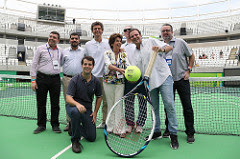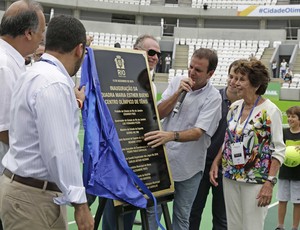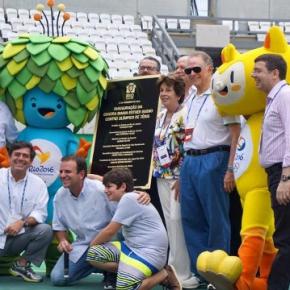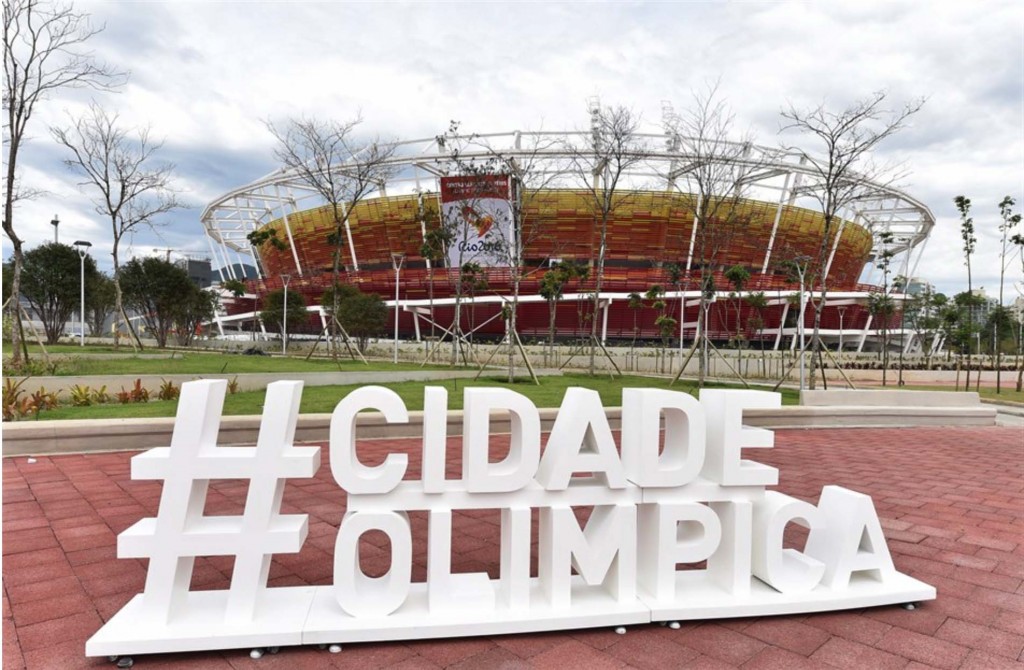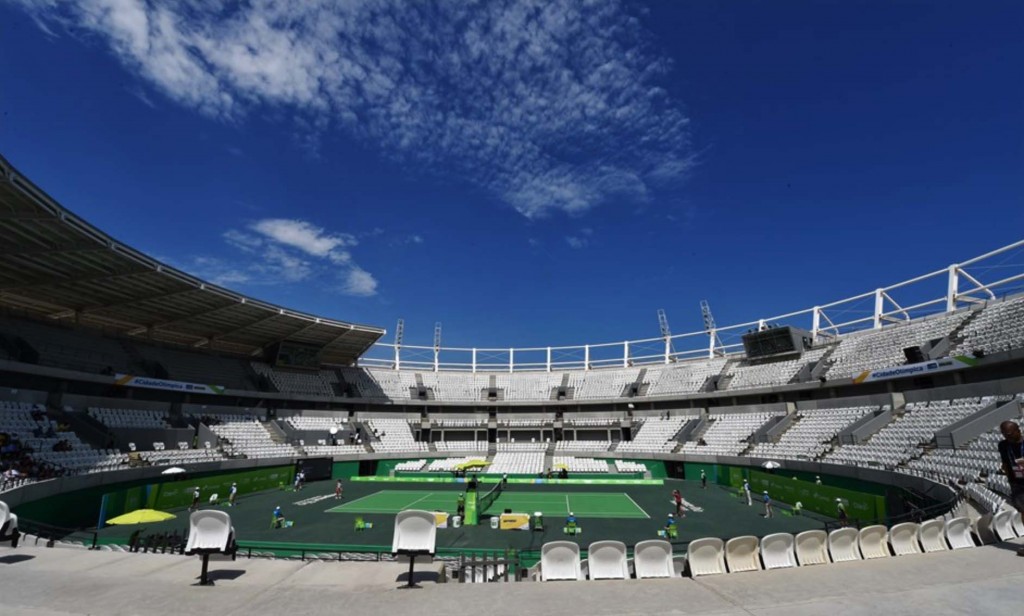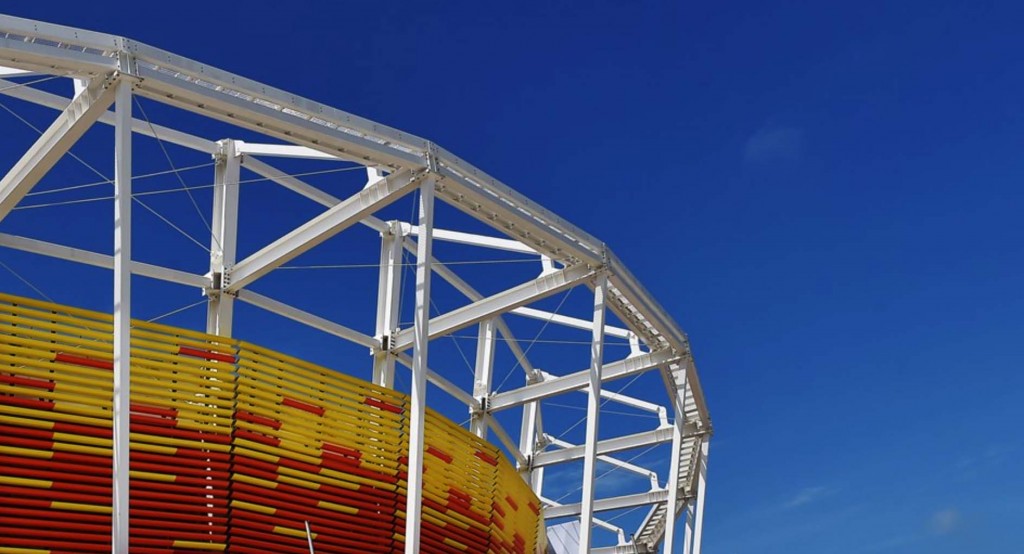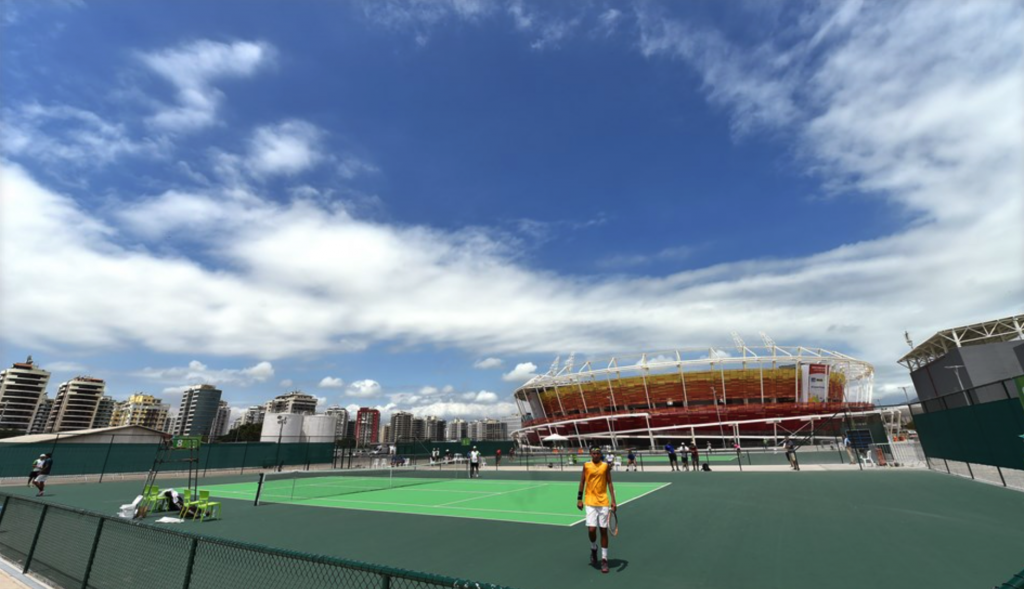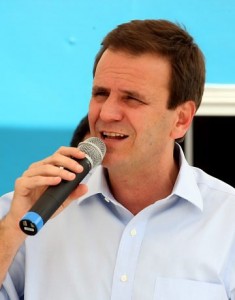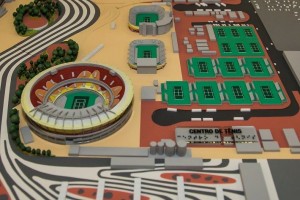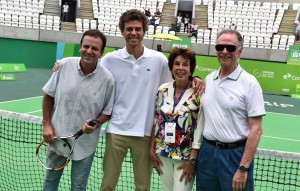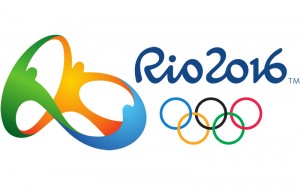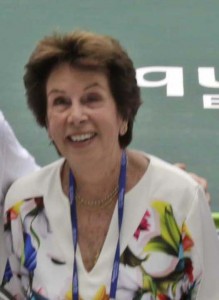 The Olympic Tennis Stadium in Rio de Janeiro is to carry the name of Maria Esther Bueno for posterity.
The Olympic Tennis Stadium in Rio de Janeiro is to carry the name of Maria Esther Bueno for posterity.
“It is unbelievable!” Maria Esther Bueno told her website on Saturday evening.
“I was so well looked after, from the moment I arrived in Rio until I was dropped back to the airport.
“The whole occasion was just amazing, with loads of media present – photographers, press and TV – and a wonderful reception. I was very touched by it all!”
The ceremony was attended by the Mayor of Rio de Janeiro, Eduardo Paes, the State Governor, Luiz Fernando Pezão, the President of the Brazilian Olympic Committee, Carlos Arthur Nuzman, and the President of the Brazilian Tennis Confederation, Jorge Lacerda, among other government officials and representatives of the construction workers that built the stadium and the Olympic Park.
Also in attendance was Juan Margets, General Secretary of the International Tennis Federation, and Gustavo ‘Guga’ Kuerten, all paying homage together to a remarkable champion, one of Brazils’ very own.
“I can’t tell you how thrilled and excited I am to be honoured with the naming of the Olympic Tennis Stadium in my name!” Maria Esther told a press conference after the ceremony.
“It makes me feel connected with the Olympics next year in a way I never imagined possible, as well as being a part of the legacy that this fantastic place will give to tennis in years to come.”
At the official inauguration of the main show court at the Olympic Tennis Centre, held during the test event for Rio 2016, Maria Esther received the plaque which will adorn its entrance.
- Unveiling the plaque at the inauguration.
- A group photocall
“It’s the greatest thing that ever happened to me,” the 19 Grand Slam champion told the assembled dignitaries and guests.
“We think nothing beats the great thrill of winning, but this is really fantastic, one of the greatest honours of my life.
“I am very proud to have been able to represent Brazil so well over my lifetime.”
“This is also a great victory for Brazilian woman, because women have to work three times harder than men [to be recognised],” said Maria Esther in her acceptance speech.
“Today is one of the happiest days of my life, just to be able to be in this fantastic arena, where we will see the world’s very best play in a few months’ time, such as [Roger] Federer, [Novak] Djokovic and Serena [Williams], all playing here in this amazing place.
“It is a very great incentive for our future players, who will have such a good place to train at, and to those who watch our sport.
“This place will help to promote out sport to many more [people].”
- The Olympic Park Rio [Photo by Paul Zimmer / ITF]
- The Maria Esther Bueno Stadium [Photo by Paul Zimmer / ITF]
- Detail of the stadium [Photo by Paul Zimmer / ITF]
- Outside court view to stadium [Photo y Paul Zimmer / ITF]
The greatest of all Latin American tennis players, Maria Esther Bueno thoroughly deserves the accolade.
Maria Esther presented two of her personal Wilson rackets to the Mayor and the President of Rio 2016, which were gratefully received.
She also took the opportunity to put the Mayor through his paces by hitting a few balls on the court to inaugurate the space on the last day of the Masters Cup, the first test event for Rio 2016 to be held in the Olympic Park.
With Nuzman, President of Rio 2016, Ricardo Leyser, Secretary of the Ministry of Sports, and Guga, a three-time winner of Roland Garros, watching, the Mayor was offered a giant racket to help his play.
“It is a great pleasure to be here, inaugurating and delivering the first sport at the Olympic Park, on cost and on time,” said Mr Paes.
“But more importantly, it is to be able to honour a great Brazilian, the woman who put our country on the world map, winning 19 Grand Slams in her career, by naming this wonderful arena the Maria Esther Bueno Stadium.
“Brazil has many challenges and problems as we are experiencing a political crisis, but I think it’s important to show that this country is able to make and deliver what was promised.
“Every coming month, Nuzman and I will deliver you a new Olympic stadium in this most beautiful Olympic Park, adding to the history of this fantastic city that is Rio de Janeiro.
“Viva Maria Esther Bueno! Viva the Olympics! Viva Rio and Brazil!”
It is reported that our three-time Wimbledon singles champion and owner of four singles titles at the US Open, started her acceptance speech, visibly moved.
“I have no words to express my gratitude or to say how happy I am.
“This is one of the happiest days of my life and undoubtedly one of the greatest honours I have ever received in my life.
“I’m tremendously excited. I cannot even tell you how much it means to have been able to put my name on such a wonderful stadium, an Olympic stadium.
“I’m sure the Olympics in Brazil will be the world’s best.
“Everyone has been wondering if the Games are going to be ready, no-one trusted us, but arriving here and seeing this magnificent stadium just shows it will come together and be great.
“I want to congratulate everyone who cooperated with the works and thank you all for this great honour. I never expected that.
“I’m sure I’ll leave my legacy for women and future athletes,” she concluded.
The Olympic Tennis Centre has 16 hard courts, the main one of which is the Maria Esther Bueno Stadium with a capacity for 10,000 people that will be permanent arena.
The second largest show court with 5,000 seats, will be temporary, while the third, with 3,000 seats, will remain after the Olympics but without the stands.
There will also be 13 smaller courts: seven of them with 250 seats each for matches and the remaining reserved for practice and warm-ups.
The main arena and the nine secondary courts were used for the test event last week, which fielded 66 tennis players and 8 wheelchair players.
The Olympic Tennis Centre took an investment of around $50 million (£32.5m) to build and will require an estimated additional $2.75 million (£1.8m) a year to maintain.
Of the total amount, $6.8 million (£4.5m) came from the City Hall and $45 million (£30m) was funded by the Federal Government, with the balance from private investors.
Executive Secretary of the Ministry of Sport and acting minister, Marcos Jorge, also on hand to celebrate the opening of the new facility.
“I come here to represent the Minister, George Hilton, who is on an official trip in Portugal.
“I am very happy to see this tribute to Maria Esther. This stage leaves nothing to be desired against any other worldwide.
“The Federal Government has fulfilled this delivery and I have only to thank everyone,” added Marcos Jorge.
After the Olympics, the nine permanent courts will be a legacy for the sport under a plan conceived by the Brazilian Tennis Confederation (CBT) that has been presented to the City Hall and the State Government, but is still in the process of being analysed by the Sports Ministry.
The idea is to transform the space to focus on the training of high performance athletes, who would stay in apartments and hotels in the area, as well as to provide programmes for children and adolescents from local social projects and to host future national and international competitions .
The proposed plans, which were inspired by the facility at Roland Garros in Paris, will be funded by the CBT through sponsorship.
“Our goal is to become home to the National Tennis,” explained the President of CBT, Jorge Lacerda.
“Bringing the entity’s management here from Sao Paulo to Rio and using this training centre to receive the greatest sports events.
“Tennis players travel a lot, but they need a place to train in Brazil.
“The courts would be public and would also have community projects to help more than eight thousand young people in Brazil [engage with the sport].
“We have financial viability, and can achieve this without using public funds.
“We could bring the Rio Open here, if there is interest, the Davis Cup, or any major event.”
Guga also stressed the importance of the legacy after 2016 and said that education and sport are great tools for social inclusion: “There is an immediate responsibility to take care of this space as best as possible.
“It is a huge opportunity for the Brazilian tennis, but that doesn’t only depend on the centre, it depends on other factors and we need to keep working and evolving to take advantage of this opportunity.
Maria Esther agrees: “Sport crosses many obstacles in life but it can’t solve every problem of society – that needs everyone working together to help build a better future.
“I am sure this stadium, which rivals the best show courts in the world, will create its own legacy in the rights hands.
“To be associated with that in a small way is a very great honour to me and one that I will always cherish.”
A total of 70 competitors took part in Brazilian tennis’s year-end finals.
Thiago Monteiro and Gabriela Ce won the men’s and women’s titles, while junior events were held in the 16, 14 and 12-and-under age groups.
Wheelchair tennis player Natalia Mayara, who has already secured her place in the Paralympic Tennis Event after her win at the Parapan American Games, won the women’s wheelchair title.
Two exhibition matches were also held at the venue, with Bruno Soares and Joao Souza facing Marcelo Demolioner and Andre Sa in a doubles match on Friday, and Brazilian No 1 Thomaz Bellucci taking on Rogerio Dutra Silva on Saturday.
The test event allowed officials from Rio 2016 and the ITF to look at all aspects of the Tennis Centre in play, with the centre in its final stages of construction.
The Rio Olympic Tennis Event will be held on 6-14 August 2016, with the Paralympic Tennis Event taking place on 9-16 September.

